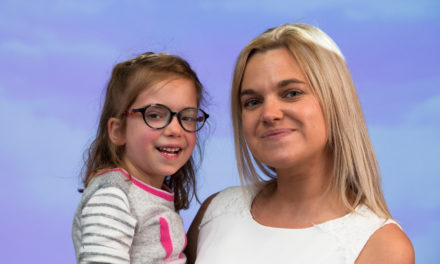Roger Neilson House’s recreation therapy program offers children with complex needs a rewarding experience
By Janet Wilson
For Jaxon Elliott-Sprysa, Roger Neilson House is his home-away-from-home. Despite spending five days a month there for pain and support management, the 14-year-old counts down the days and has his bags packed and ready to go.
“Jaxon absolutely loves the house – we all do,” says mom Dana Elliott-Sprysa. “My son has been accessing the house for 10 years, while my 12-year-old daughter Savannah attends the sibling group and one-on-one sessions.”
Jaxon, who has visceral myopathy of the large and small bowel, loves to play video games, watch movies and hang out with recreational therapists Katt Brooks and Danielle Scarlett.
“I can’t say enough about Katt and Danielle. They are the heart of Roger Neilson House,” says Elliott-Sprysa.
 Brooks has worked at the Ottawa palliative-care pediatric centre for almost six years and was drawn to her profession in high school after working with children with special needs.
Brooks has worked at the Ottawa palliative-care pediatric centre for almost six years and was drawn to her profession in high school after working with children with special needs.
“I did a work placement at Roger Neilson House and loved every minute. I still do. Even after a difficult day, I go home and think about the beautiful, trusting relationships we have created with the children and their families. It’s such a privilege to work here.”
Brooks says improving the quality of life for a child facing a life-limiting illness is the most rewarding aspect of her job.
“When they smile and laugh, it’s the best feeling in the world. The purpose of our profession is to help children with complex needs express their emotions and to break down barriers for them. We let kids be kids.”
In 2003, Roger Neilson House opened its doors on the grounds of the Children’s Hospital of Eastern Ontario. The eight-bed facility was named for Roger Neilson, the beloved Ottawa Senators coach who died of cancer in June 2003, and was built in collaboration with the Ottawa Senators Foundation, CHEO, government departments and the Ottawa community.
The recreation therapy program is customized based on a child’s needs and provides a calming influence and the opportunity for self-expression. Sensory play is explored through tactile activities, art and crafts, music and yoga.
When devising their weekly themes and activities, Brooks and Scarlett often get the entire house involved in the fun. The pair recently hosted an annual Hallowe’en party where the children dressed up in costumes, painted pumpkins, toured a haunted house and made spooky food crafts.
“All the children and their families who access the house were invited. It’s really beautiful to see families enjoy a normal activity in a fun, informal environment,” says Brooks.
 Other themes organized by the co-workers involve time travel to the dinosaur and cave-man eras, taking a trip to outer space or dressing up like a shark for Shark Day. For children with visual and hearing impairments, the therapists gently assist patients to smell, touch and feel objects while playing basic games or taking part in scavenger hunts.
Other themes organized by the co-workers involve time travel to the dinosaur and cave-man eras, taking a trip to outer space or dressing up like a shark for Shark Day. For children with visual and hearing impairments, the therapists gently assist patients to smell, touch and feel objects while playing basic games or taking part in scavenger hunts.
“We’ve held a prom party here for one girl who couldn’t go to her school prom. We’ve brought in a real pony for My Little Pony day. Highly complex kids might not be able to move their hands and 85 per cent of our children are in wheelchairs. We adapt our programming to make it accessible for all. We give them choices during play when they often don’t get to make many choices for themselves,” Brooks says.
Megan Wright is executive director of Roger Neilson House and director of palliative care for the Children’s Hospital of Eastern Ontario and the Ottawa Children’s Treatment Centre. She credits the recreation therapy program with enriching the lives of the children, their families and her entire staff.
“In the last year, we have added a Zen zone, yoga, music care and summer camp. When we have one of our famous dance parties, the whole house takes part and the atmosphere is electric. I am so proud to work with the Roger Neilson House team.”
 For Scarlett, hearing a non-verbal child make a happy sound, smile or laugh is the reason why she does her job. “You can see in their face that they know someone is listening to them. It’s very validating and rewarding.”
For Scarlett, hearing a non-verbal child make a happy sound, smile or laugh is the reason why she does her job. “You can see in their face that they know someone is listening to them. It’s very validating and rewarding.”
For more information, visit rogerneilsonhouse.ca







